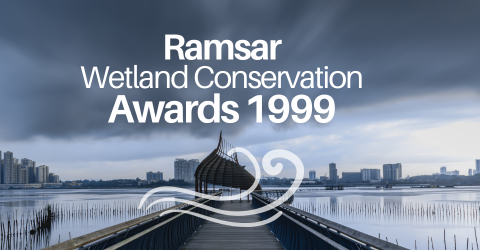
NGO Award 1999 - Lake Naivasha Riparian Association
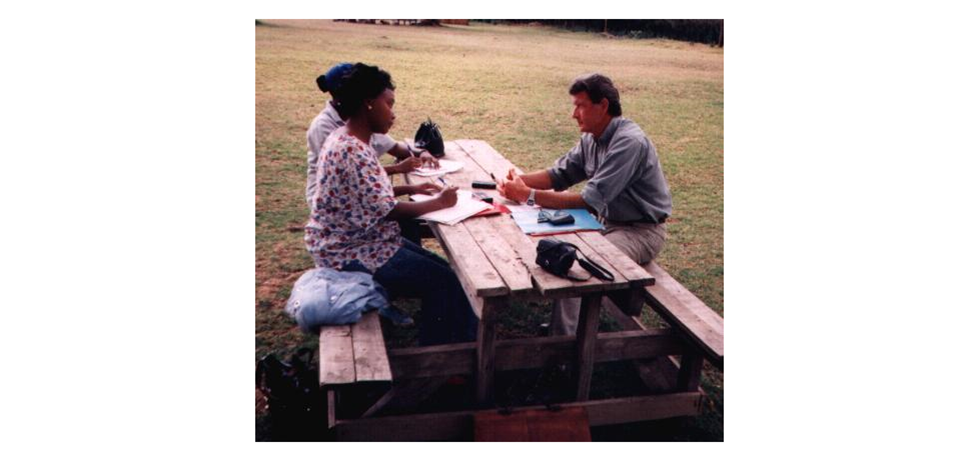
Lake Naivasha Riparian Association, Kenya
Lake Naivasha Riparian Association (LNRA) is a pioneer example of a local community taking the lead, initiating major actions, and achieving results for the long-term conservation and wise use of wetlands. It is an outstanding demonstration of how to implement two major objectives of the Convention on Wetlands: conservation and wise use of wetlands for the well-being of local populations, by building consensus on major issues to be addressed, and increasing commitment on the steps to be taken by various stakeholders.
Lake Naivasha is situated in the Rift Valley in Kenya, at an elevation of ca.1,880 metres above sea level. The wetland system designated as a Ramsar site in 1995 has an area of 30,000 hectares and comprises a shallow freshwater lake and a deeper crater lake. The Lake is one of the few freshwater lakes in eastern Africa and is immensely valuable to people as a source and store of water.
Formed in 1926, the Lake Naivasha Riparian Owners Association became the Lake Naivasha Riparian Association in recognition of the fact that landowners were not the only stakeholders. The Association draws its members from a variety of backgrounds, including small individual plot owners, large horticultural farmers, dairy and ranching operations, hotel owners, pastoralists, fishermen, as well as the Kenya Power Company, the Kenya Wildlife Service, Naivasha Municipal Council, the Ministry of Water Resources, the National Environmental Secretariat, the Fisheries Department, and the Ministry of Agriculture.
The main objective of the Association is to ensure sound environmental management of the lake’s resources. It advocates good practice and establishes mechanisms to implement environmental policy, legislation and regulations with each individual member, group of members, and the relevant government and NGO sectors.
Major achievements of the Association include:
- Designation of the Lake Naivasha Wetlands as a Ramsar site;
- Development of a management plan for the Ramsar site (1996), with a view to extending the plan to the catchment during the implementation process;
- Creation of a Management Plan Implementation Committee to steer the implementation of the plan (1997);
- Development of Codes of Conduct representative of the wider community including Government, annexed to the management plan, for various groups of stakeholders (flower growers, tourism operators, beef and dairy producers, urban developers, geothermal power generation).
- Acting as a catalyst in processes such as the introduction of dripfeed irrigation, upgrading the municipal sewage treatment works, opposing the alienation of riparian land, etc..
- Beginning the long-term monitoring process from which to revise and update the management plan.
LNRA is an inspiring example of community leadership, and it demonstrates that conservation and wise use of wetlands can be achieved in Africa.
Interview with the Chairman of the Lake Naivasha Riparian Association concerning management of the Lake Naivasha Ramsar site, Kenya, 9th January, 1999
Andrew Lord Enniskillen, LNRA, interviewed by Catherine Mgendi and Susan Matindi
Q. Please start by giving us some background on yourself and your involvement in the LNRA
My involvement started when I came to Lake Naivasha. First I bought a small farm on the southwest corner of the lake which has riparian land which goes down to the lake. I came here without knowing very much about Naivasha and its background, and I started to get involved as a member of the Association. I attended meetings and, for reasons best known to the membership, they decided 15 years ago that I was the right person to chair, and I have been the Chairman of the Association ever since.
Q. You became chairman 15 years ago?
Yes, 15 years ago. But my background is that I am a professional pilot and a company director (of many companies, including the national airline, Kenya Airways), and I am a farmer, born and bred.
Q. What is the Lake Naivasha Riparian Association and how did it develop?
The Association was started in 1927 and it was an association of all the riparian landowners around the lake. At that time one of the primary purposes of its formation was to administer an agreement that was subsequently developed by the government to look after the riparian land around the lake. Riparian land is land covered and uncovered by the rising and falling lake waters. So it is "no man’s land", if you like, between the owned lands surrounding the lake, the buffer zone, and the lake water itself. The riparian land management agreement was formalised by an act of the government at that time, which was ratified by the Kenya Government in 1963. The landowners have used this to manage the riparian land, but they do not own it and may not establish permanent structures on it. So the Association was formed to administer that agreement and to arbitrate in any disputes over boundaries or use of land and so on.
More recently, because of the tremendous growth in development around the lake, with its potential for damage to the ecosystem, we became aware that there wasn’t any other single authority on Lake Naivasha. Somebody had to try and put in place a management plan for the sustainable use of the lake and its surroundings and resources, and we decided to do it ourselves, through voluntary contributions from our members - in money and time.
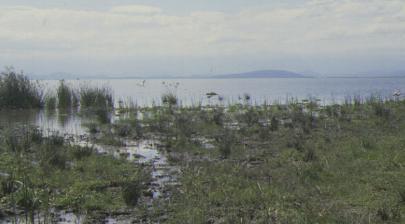
So at the moment the Association is a group whose membership is drawn from all those who own land abutting the lake. These include membership among hotels, tourist operations, the Kenya Power Company, ranch owners, flower growers, small farmers, domestic plot owners, cooperatives, and the Naivasha Municipal Council itself. We have a cross section of all sorts of institutions and individuals - the only common denominator being that they own the land surrounding Lake Naivasha.
I think it is important to stress that membership of LNRA doesn’t imply what many people automatically think of them in terms of land ownership for the privileged few; while there are a number of those (yes), there are also small farmers, government installations and institutions responsible for research and education … and so on.
Q. Are all the landowners members?
Yes. Under the constitution, anybody who owns land abutting the riparian land of Lake Naivasha is automatically a member . They become active paid up and voting members by contributing a small annual subscription which at the moment is KSh500/= a year. And the membership at the moment is about 140. But bear in mind that among those 140 landowners, one member might represent one person or one member might represent 20 or 30 thousand individuals.
Q. What is LNRA’s vision of its mission and of wetland conservation?
One thing that binds all of us together is the well-being of the lake. There are many members genuinely concerned about the environment, for the well-being of the biodiversity represented here, for the well-being of the birds and the beasts and the water and all the resources of the area.
There are some members who would probably admit to being primarily concerned with the value of their land or the amount of fresh water available for their economic activities, and perhaps they are not primarily interested in the birds and the beasts and the biodiversity. But if it wasn’t for the birds, the beasts and the biodiversity of the lake, we would undoubtedly damage the ecosystem both qualitatively and quantitatively because the biodiversity provides the filter to prevent, for instance, pollution from run off and nutrient enrichment of the lake waters. At the end of the day, therefore, everybody who owns land around the lake has vested interests in the health of the lake, qualitatively for keeping it as a fresh water resource (which is almost uniquely so, if you compare it with other Rift Valley lakes in this region) and also quantitatively, mainly as a significantly large body of water that can withstand the natural cycles of dry and wet and support all this development.
Q. Would you describe Lake Naivasha and its value for wetland conservation in Kenya?
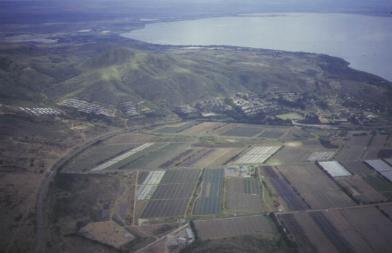
First let me go back to the former question: LNRA’s vision or its mission: we feel we are fortunate enough as members of the association to have inherited for a lifetime this natural and international resource – it is ours to enjoy and look after for a lifetime and to hand on in at least as good, if not better, condition as we found it. And we found we have to remember that the development started to increase around the lake in the last 20 years – well within living memory. Some members can remember the days when the lake was very different; it was higher, it had water lilies and other attributes that have since disappeared . The flower industry was at its infancy; it had only just started. There have been lots of changes, but our mission is to accommodate these changes for extremely good reasons of economic development, foreign exchange earnings, employment, and so on, whilst at the same time making sure we do not destroy the resource. So that leads me into your question to describe the Lake and its values.
First and foremost it is of enormous value to the country as a natural reservoir of freshwater - of which we have very few. Of course we have Lake Victoria, but that is at the far corner of the country and only benefits that immediate area; it does not benefit the country as a whole in the same way as Naivasha. We have rivers, but they are very much influenced by the seasonal drys and wets and very few of them can be relied upon. So Lake Naivasha is enormously important as a reliable resource of fresh water and as such it comes under tremendous pressure from development – national development, district development, and private development – and there is only so much abstraction that it is possible to accommodate. So one of the lake’s values is obvious: it is a freshwater resource and that freshwater can be used as it is, and for economic development, for job creation, for foreign exchange earning and so on. But it is also a unique ecosystem - certainly in this part of the world, and also worldwide - which is under intense pressure from development as it is a basin lake with no outlet. It rises and falls in the natural cycle over a tremendous volume which translates into a very large acreage of land covered and uncovered at different stages of the cycle.
We are talking about a lake which has a volume of about 50 million cubic meters at its lowest (dry) cycle to about 170 million m3 in its full or wet cycle. In the extreme it has been dry (without water) within the last 100 years or so. So you can appreciate that this is a lake which is constantly changing. Expanding, contracting, exposing great acreages of riparian land which are highly fertile and available - which then within a short period of a month or two (as we have seen in the El Niño rains of last year) are completely covered and flooded.
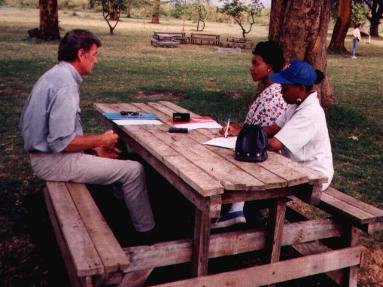
LNRA’s purpose here is to try and control man’s natural excesses. A low lake level means available riparian land but it can be flooded tomorrow, and if we allow the riparian land to be exploited in the wrong way, we will undoubtedly damage the whole resource in the long term. So it is not only a value for the country, I believe it is also a great value internationally because it is a Ramsar Site. This implies it has international significant for wetland birds, bird migration roosts and all those scientific things. But also I believe we have been an example that the rest of the world can look to for some ideas and different approaches as to how we cope with this tremendous conflict over the needs and wants for water and land.
This is a Ramsar site, but it is entirely surrounded by private land. It is not a park, it is not legislated, it is not regulated, it is left to the community to voluntarily look after. I believe this has been one of the unique parts of this process towards consulting local people and getting its Management Plan in place. It is a community initiative: it has not been forced upon us, we did it voluntarily, and any success that we have had has been because of the commitment of the community to the process and also the understanding of the authorities, who so easily might have just realised that Naivasha is an important resource and drawn a line around it to make a reserve or a national park.
Kenya’s other Ramser Site, Lake Nakuru, is a very different issue as it is a National Park. We feel Lake Naivasha can provide some example of a community-based initiative which, at the end of the day, will have much more strength from support from the community because of the very fact that it is a community initiative. Nobody from on high is telling us what to do, how to do it and when to do it. It is managed for the good of the community and the country as a whole.
As for the Naivasha Ramsar site’s biodiversity, I am not a scientist, but I am told and persuaded that it has a remarkably rich biodiversity. I am a landowner, so I know it from my own experience on a little farm which is 1200 acres of very dry country, but on that 1200 acres we have 290 species of birds and 44 species of mammals, including about every thing except elephant and rhino. And that seems to me to illustrate the tremendous biodiversity of this part of the world, but at the same time next door to my farm, almost next door to me, you will find fully developed flower farms where the entire acreage is given over to plastic development. But I think the balance of the two which you find in this areas is what makes it unique and important. Some people are experts in growing flowers, others feel they would rather do a different thing, and the importance of the LNRA initiative is to make sure that neither one nor the other dominates - because we need both. We cannot sit on a freshwater resource of such magnitude and do nothing with it, but equally we must not exploit it unsustainably.
Q. Could you describe the progress already made by LNRA on the Management Plan?
The process to develop the plan started in 1993. The plan evolved from frustrations about the various regulations which were seen as very constraining in one regard and which impaired the ability of the landowner to look after his land, and yet were sensible. An example was the absolute ban on the cutting of trees. In principle this is fine, but in practice if you have a dangerous tree, and you are trying to maintain a fence, then there is nothing wrong in cutting down that one tree. What is wrong is the wholesale removal of all trees and putting in their place something else which is not conducive to the conservation of the environment. So these regulations were frustrating and were seen not to make sense. During the process of trying to argue through the rights and wrongs of some of these regulations, it became abundantly clear that there was nobody in charge. The Ministry of Agriculture had a say, and so did the Department of Forestry; the Municipal Council had a say, the District Administration had a say, but who was in charge overall? Nobody. Trying to get sensible decisions made when there is nobody ultimately in charge but when everyone has a vested interest, made it very difficult. As a result the lake was made to suffer as developments were going ahead without proper consideration and approval.
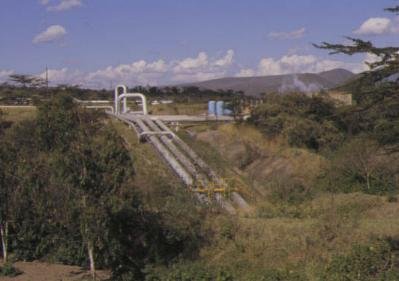
Photo: Naivasha geothermal plant
So the Plan evolved naturally. The first thing we decided we must do was to try and collect all the information relevant to the writing of a Management Plan and put it in one document . This was done through a consultancy that we funded as an association, and that was the first phase of the Plan.
The second phase was to develop a Management Plan which would have the support of the entire community and which could be seen to evolve from grassroots, not be imposed by a few decision-makers.
In order to write the Plan, it was important to widen the scope of the involvement and we co-opted (for instance) IUCN and various government ministries which weren't necessarily directly represented on the ground, but which could give useful input to the development of the Management Plan. We had people from the universities doing the academic work, and we formed a Steering Committee of 10 to 12 people who were involved for nearly two years in writing the Management Plan from the knowledge gained through Phase I and from their individual experiences.
During that time we were also lobbying our membership and government to have the lake declared a Ramsar site because there were great benefits in doing so. This is where some of the negative side of the process came out. There were people who were convinced that if we became a Ramsar Site, we would stop them growing flowers. There were members who were convinced that by becoming a Ramsar site, we were effectively trying to save species and ignore the needs of people. We had to go through that process, educate and make them aware of what we were trying to do. I am glad to say it was a relatively short time; we were delayed by probably about a year but eventually we got the consensus of the entire membership to support the plan and adopt it. And then from there we went to the Government through the District Development Committee in Naivasha, and the Plan was approved there, and then a copy was presented to the President for the ultimate seal of approval. And since that time, late 1997, when it was finally approved, we have been in the third phase of the implementation of the Management Plan. The implementation phase began in 1997 and will go on, hopefully, forever because we will never complete that process. It is a dynamic situation which changes as the wet and dry cycles change, as technology changes. Flower growing is a tremendously important crop today – it might not be in 10 years, and something else might replace it and our knowledge will change (and hopefully increase) and we will change our views and possibly our objectives.
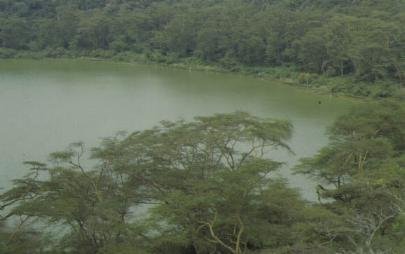
The implementation process is being handled by an Implementation Committee, which at the moment I chair, and which consists of twelve organisations, through their nominated representatives. It is important to stress the nominated representatives, for while it is the organisations that are members, inevitably organisations can be represented by many different people, and if you get a different person turning up each time, you have to go back over what you have done and give the background afresh. We therefore insist on those organizations being represented by nominees and on the whole they should not change. We are getting tremendous support for the process; we have meetings every six weeks or so, and the turnout has been remarkably good.
Q: What problems are faced in the conservation of the lake?
The main problem is understanding. Once people understand what we are trying to achieve and why, they can be turned from negative to positive. It is not always easy to get the opportunity to be able to put across the reasons for our activities. Why do we insist on water meters for instance? It is not because we want to charge water users, or regulate them, or even stop them from using the water; it is because we need to know how much water is being abstracted. Why are we discouraging moving down with the receding lake, and cultivating on the riparian land, which, after all, is highly productive? It could be used for growing food or even settling the landless. We are doing this because it is an absolutely essential part of conserving the land as a whole. There are individual cases of abuse, despite all our efforts. During the El Niño period, the lake came up and flooded areas of extensively cultivated land; you could see the rising lake water flooding sewage systems, latrines sitting out in the middle of the lake, even one or two houses. These are individual abuses which go back to a lack of understanding. So I think our main problem has been trying to convince the more obstinate among us in the community about why we are doing this. It is not because we have a selfish agenda but because we have a determination to conserve the lake and the entire wetland area and to prevent it being destroyed by man’s greed.
This particular lake, being a basin with no outlet, and being surrounded by relatively primitive sewerage systems, the municipal system, individual domestic systems, pit latrines and also intensive agricultural activity with all the dangerous pesticides plus pressure from livestock, plus siltation from rivers coming down the various steep slopes around the lake …. it could be easily destroyed, in a very short space of time. We have a situation here where 20 years ago we had a population of 50,000 people and now they are estimated at 250,000.
The lack of understanding stretches to government. There are dedicated people on the Implementation Committee as individuals representing government ministries, but that is not to say that the Ministry as a whole understands the problem, or even gives it much priority. That is a process that has to go on. Those individuals have a responsibility to go back to their parent ministries and make the entirety of government understand the process of conservation and sustainable natural resource management.
Q. What do you perceive of the Convention on Wetlands?
I perceive the Convention on Wetlands, first and foremost, as a laudable effort to conserve wetlands worldwide, because those of us who are lucky enough to live in a wetland are those who can fully appreciate the benefits of the tremendous biodiversity, and the general sense of well-being, just living in an area that has water, when so much of the country is disadvantaged and people have to walk miles to get drinking water, let alone water for other uses.
Secondly, I perceive Ramsar as an organization whose membership is composed of governments, and therefore where we have no direct relationship with the organizations, we are just citizens of the member government.
Thirdly it is an international organisation which can bring pressure to bear on governments, where their own policies tend to damage the wetland resource. One of the reasons we felt it was important to get Naivasha designated as a Ramsar site was to bring the international spotlight on this resource, recognising that it has enormous potential for over-exploitation. This might well be understandable government policy. If a government is faced with famine or the need to find jobs for a booming population, it might be legitimate to exploit this resource, and so we feel that the Convention on Wetlands could play a very important part in moderating such excesses if they were to occur.
The Convention is starting to play a part in conserving Lake Naivasha. The process is just beginning; we have only been a Ramsar site for three years and one of the first requirements of a Ramsar site is to have a management plan in place. We were able to fulfill that as we were already working on it. I think one of the most important parts that Ramsar can play is in building awareness. These international Conventions where you have delegates from Kenya, going to Ramsar COP meetings, interfacing with people from other countries, are very important for our local initiatives. It is also important that they start talking about Lake Naivasha and what is going on here, to build awareness among the decision-makers, nationally and internationally, something that you can not really do on your own unless you have got tremendous resources for publicity - which we do not have. So it seems Conventions like Ramsar can play a valuable role in promoting awareness of the value of wetlands and their needs for wise use, not just within the country, but internationally.
Q. How did you receive the news that you had won the award and what does it mean to you and to the Association?
With tremendous surprise, while on leave in England, over the phone! I was every excited. We knew we’d been nominated, and we felt it was a great honour to be nominated, after all the Ramsar award is a worldwide award, but we were very surprised to win it - and, of course, very pleased.
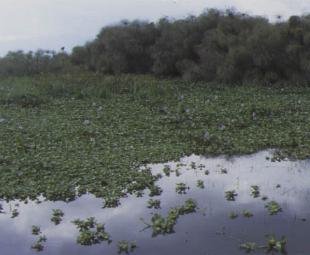
Photo: Eichhornia crassipes
It is highly significant to us, as it lends a seal of approval to what we are doing and gives enormous encouragement to the main players in this process, who often (myself included) have been tempted to give up, because it is so long-term and against such odds, with many people who just don’t seem to understand but are not willing to spend five minutes to try and understand. Year after year we work at this process and sometimes seem to take a step forward and then three steps back the next day. But the award has given us great encouragement on the ground. The importance and success of the Management Plan process for the wetlands of Naivasha will only be of significance if we can get the Kenya Government and the Kenyan community at large to see it as a priority issue which has national significance, and when we can show that it can be done successfully. Before we won the award people said the Ramsar status and the management plan were "interesting" but "so what?". Now it is like a professional qualification, we feel we have "graduated’ by receiving international support through the award. The value is way beyond the award itself. It is doubly significant because we are hosting an international conference on wetland management here in April this year. This is a meeting entitled "Shallow Tropical Waters and Humans" which we are running with IUCN, the Kenya Wildlife Service, and others and which will bring people with experience in wetland management to the Ramsar site to discuss management issues - even before the Ramsar award has been presented to us (at the COP in Costa Rica in May).
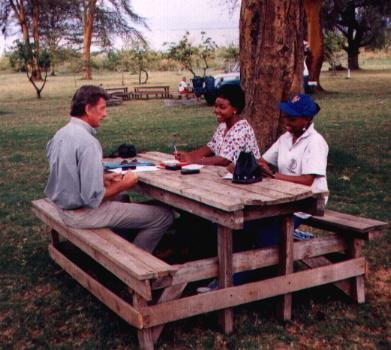
We believe the award is worth US$5000 as we are sharing the prize with an organisation in Greece. The prize money (KSh300,000/=) will be helpful in supporting the management process which includes many projects. We need KSh 7 million for one project to upgrade the sewerage system of the Naivasha Municipal Council, so the award will be seen as seed money to raise further funds and to give encouragement to our members who have been so generous in the past.
Q: What is the vision of LNRA towards the implementation of Ramsar wise use principles at Lake Naivasha?
I would answer that by saying that it just so happens that our principles coincide. I don’t think we set out to follow Ramsar wise use principles, it’s just what seemed sensible to us, the wise use of the resource, using the resource in a sustainable way, sort of maximum economic development without damaging the base. These just happen to be the principles of Ramsar, which only illustrates how sensible Ramsar is and hopefully how sensible we are. We didn’t pick up a textbook and say this is what we are supposed to do, it just naturally developed. Because here we are in a country which desperately needs jobs, foreign exchange, etc., and so if you are to start from the premise that the economic activity has to be sustained, how do you sustain it without damaging the resource? If you damage the resource the economic activity will dry up. The flower growing, tourism, etc., seemed just natural and perhaps we are lucky to have in the community a sufficient number of people who can see the benefit of preserving the biodiversity and at the same time promoting necessary economic activity.
Q. And finally, what are LNRA’s plans for the future?
I hope to play a more and more backseat part. The LNRA is not constituted as, and does not want to be, a front runner in all the administrative, financial and political problems of trying to lead the community in the direction we believe we should go, and once the awareness and the education, the appreciation is out there among the community, I don’t see why the LNRA should not begin to take a backseat. We’ll always be there, I’m sure, but it would be a wonderful thing if the community really understood and believed in their hearts what we need to do so that there really isn’t a need to have us there. All we are doing is providing a medium or a leadership position for the community. We are all individuals with our own agendas and priorities… I am a farmer and a business man, I am doing this really to help for the moment, but I hope sooner or later someone else comes and takes over. As long as the process continues, we’ll have done our part.